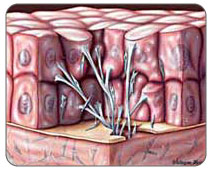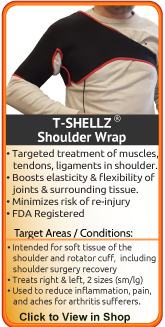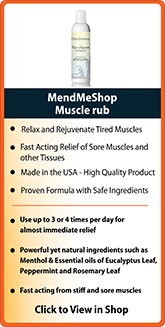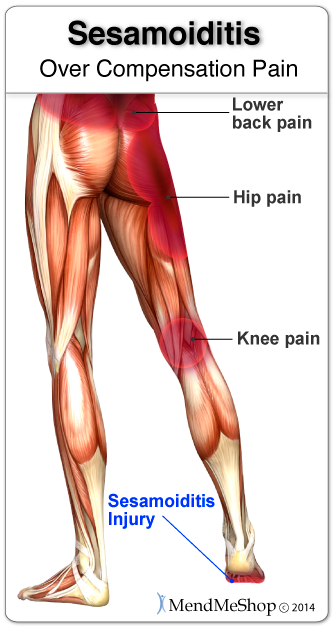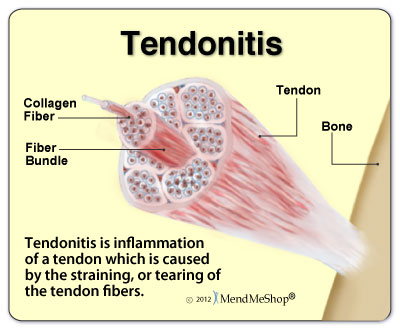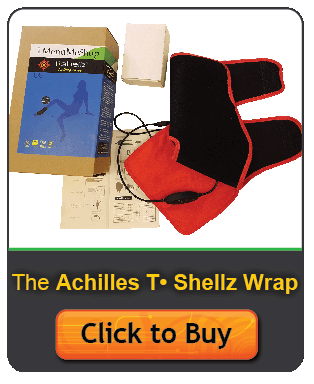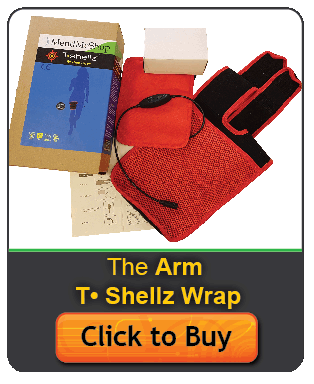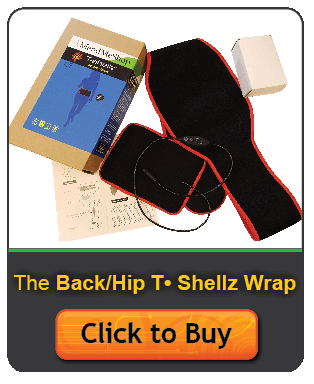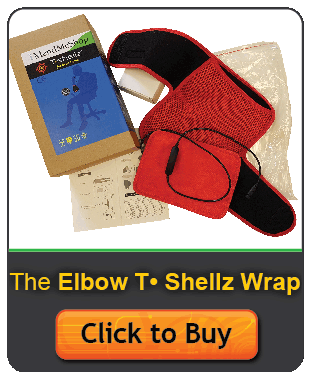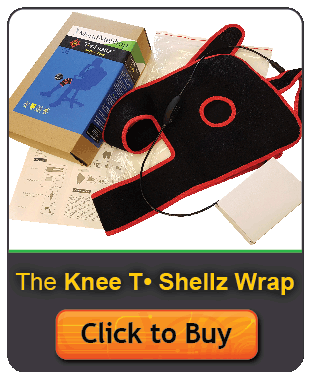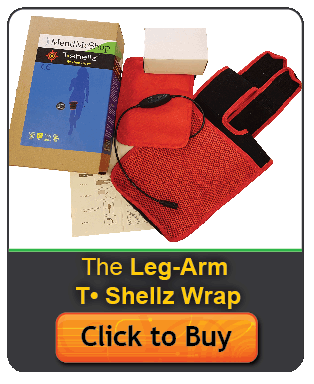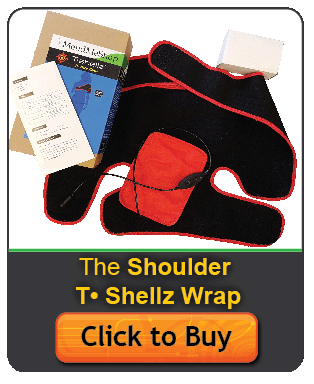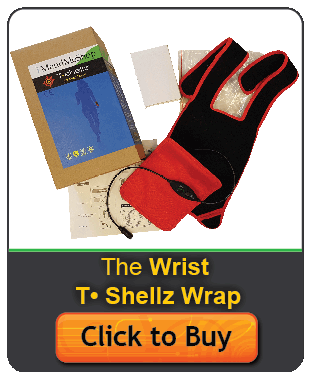Dealing with Chronic Tendonitis
What is Chronic Tendonitis?
You might have chronic tendonitis if:
- You have constant pain interfering with your daily life.
- You've experienced on-going dull, aching, sharp, throbbing and/or radiating pain that just won't go away.
- From time to time you get tenderness or swelling in and around the injured area.
- Your soft tissue feels weak and stiff - severely reducing your mobility and range of motion.
- You have difficulty using and relying on the affected area - ie. it's hard to grip items, carry anything, walk normally, run or stay active, you have trouble sleeping or you're finding it hard to dress yourself.
- You have an on-going injury that you wish had healed by now, but the aching, throbbing, radiating pain just won't go away.
If you already know or suspect that you're suffering from chronic tendinitis then you're probably familiar with the need to constantly manage your pain. You're probably used to changing the way you walk or carrying things to avoid using the area of your body affected by chronic tendonitis.
If you've been working with a doctor, maybe the only choices presented to you so far are living off of anti-inflammatory drugs (NSAIDs) or filling prescriptions. If the pills don't work, you might assume the next step is surgery.
These methods for managing your chronic pain and stiffness are doing nothing to actually work with what your body has available. Our bodies are resilient, adaptive, amazing pieces of machinery. Our brains automatically know to change the way our bodies work to adapt to any change in condition - from changes in temperature outside, to a stubbed toe, to even a chronic case of tendonitis.
Relying on medications to fix a case of chronic tendonitis is like turning off the signals your brain is giving you (pain is a warning signal). Does that mean your injury is gone? No. It just means you've shut off your body's only way of telling you that somethings wrong and your injury STILL isn't healed.
At this point you're probably telling yourself:
"I don't want to pop pills for the rest of my life."
"Why is surgery the only answer?"
Often with chronic tendonitis there's also more than 1 injury going on. You might even be suffering from a series of inter-related conditions. For example if you have foot tendonitis (or sesamoiditis), you might feel some lower back, hip, thigh or even knee pain on that same side (or even the opposite 'healthy' side). If you've started noticing secondary pain, it's likely this pain is still being caused by your original injury. If you haven't received a proper diagnosis you may not even be aware of the true cause for all of your pain.
In all of these situations - when trying to avoid taking pills to manage pain, resorting to surgery or treating a series of conditions for 1 tendonitis injury - conservative treatment methods are the solution. The best way manage a chronic case of tendonitis is by introducing long-term conservative treatment methods that work with your body instead of disguising the problem.
Your body is capable of doing 2 very important things - functioning and healing. Your body is already functioning the best it can with your condition, now it's time to wake up your body's ability to heal.
No one wants to live with chronic pain - and you no longer have to!
How Did Your Pain Get So Bad?
You might say to yourself "How did I get chronic tendonitis"?
It all started with an acute or overuse (repetitive movement) injury to your tendon. You probably rested for a few days and thought once swelling or inflammation (the pain) was gone that the injury was better. We make the mistake of returning to regular activities too soon without proper time for healing. The truth is that healing takes time and after the swelling is gone your injury isn't even close to being fully healed.
Acute tendonitis will start healing in about 2 - 4 weeks.
Chronic tendinitis can take more than 6 weeks to heal, and sometimes goes on for years, when it is left untreated.
Why Does it Take So Long to Heal Chronic Tendonitis?
Every time we have an injury, we start to heal right away. This is an 'active healing' time when your body sends extra blood that is full of oxygen, nutrients and fluid to the injury via inflammation to heal you and get rid of damaged tissue.
As inflammation reduces and 'long-term healing' begins, scar tissue (adhesions) are laid down and act like a band-aid over the injury. This scar tissue acts as a foundation for the tissue repair. Scar tissue is the quickest way for our bodies to heal. The scar tissue will change over time and convert into healthy / strong tissue. This phase in healing is call 'the remodeling stage'.
When you return to work, sports or activity to soon you're interrupting this remodeling stage. If your remodeling is interrupted with re-injury (more swelling and inflammation) even more scar tissue is added as a way to start the repair process over again from the beginning.
A build-up of scar tissue can have a negative impact on your overall healing;
- The weak and brittle nature of scar tissue can put you in a state of constant re-injury.
- On-going issues with stiffness, tightness, and loss of range of motion in the affected area.
- Narrowing of the sheath of tissue that surrounds the tendon, causing more pain, inflammation or swelling.
- Future issues with overall joint alignment. Enough scar tissue built up over time can pull on the bones and muscles in the affected area and pull the joint out of alignment.
As time goes on and your tendonitis persists, the second biggest problem you'll face is the fact that the 'active healing' response (inflammation / swelling / increased blood flow) is now gone. Instead you're left with a chronic injury that has low levels of on-going inflammation with a low rate of healing due to inadequate blood supply.
Sometimes you'll feel a consistent dull pain or you'll have pain any time you use the area for any activity.
Before we go further, it is important to understand that your body is capable of healing itself. This is why your physician will always try to opt for the conservative treatment first - usually, it works although it takes time to heal. Your blood flow carries oxygen and much needed nutrients to damaged tissue in the body while also flushing away toxins and waste at the same time.
Simple conservative treatments start with a Cold Compress or Ice Pack and Circulatory Boost TShellz Wrap® plus time to let your body heal.
Over-Compensation Pain = Even More Pain Added to Your Life!
Everything in the our bodies are connected and the impact of one injury can affect another area of your body - this is known as 'over-compensation pain'. Months of one area being affected by injury, using your body incorrectly to avoid pain, shifting your weight, carrying things differently or changing your movement are all actions that can lead to over-compensation pain.
For example - if you've suffered an injury from overworking your elbow playing golf you might start feeling the same pain in your other elbow. It's quite common for people to develop elbow tendonitis in both arms. Close to 4 million people in the United States seek treatment each year for symptoms of tennis elbow alone!
If you have foot tendonitis you might start shuffling on the heel of your injured foot and place more weight on your opposite, healthy foot. Shuffling your way around for a long period of time may lead to pain in the heel of your foot, knee, hip or lower back on your injured side because you are mis-aligning your entire leg (keeping it straight and off to the side).
For knee injuries you might start standing differently, putting all your weight on the other side. This consistent shift of weight can impact your other knee, hip and lower back.
If left untreated, your chronic tendonitis can lead to a complex condition including several other injuries. Any changes you make to your body or actions to compensate for your injury will change the alignment of your other joints, muscles and tendons. This is why it's so important to treat chronic tendonitis with cold compression and Circulation Boost right away AND deal with any other injuries that have happened because of your never-ending tendonitis.
Chronic Tendonitis can Lead to Other Tendon Injuries
The Difference Between Tendinosis, Tenosynovitis
and Calcific Tendonitis
Tendinosis is basically like tendonitis but it's not caused by an injury. Tendinosis is caused by chronic degeneration (wearing away) of tendon fibers over time. This is a natural thing that happens to our tissue as we age.
Where tendonitis is damage or micro-tearing to your tendon, tenosynovitis is damage or micro-tearing to the sheath covering your tendon. This sheath is a protective lining for your tendon and is made up of synovium. If this sheath is injured it can also become irritated resulting in similar symptoms as tendonitis (pain, swelling and inflammation).
Calcific Tendinitis is an injury where bone (a calcium deposit) will grow in the middle of your tendon (instead of healthy tendon tissue). There are 2 types of calcific tendonitis and both are from a chemical reaction in the body. Degenerative Calcification happens from natural aging in our body where the tissues start to break down and injury happens then calcium (bone) forms in the tendon as it heals. With reactive calcification there's generally no injury or specific event the body, but a chemical process just starts to let calcium build-up inside the tendon. Normally reactive calcification affects younger people. Both forms of calcific tendinitis can happen in any tendon in the body, normally it forms in the shoulder and rotator cuff. This condition can also happen to the elbows, wrists, hands, hips, knees, or feet - it's also known as calcific tendinopathy
It's possible for you to have tendonitis / tendinosis AND tenosynovitis at the same time creating a more complicated tendonitis injury. This weak tissue can also lead to rupture of the tendon and permanent damage.
What does this all mean to healing your chronic tendonitis? Chronic means re-occurring, your pain and injury is coming back because you haven't given it enough time to repair the tendon tissue. If you choose a treatment you should stick to it for at least 3 to 4 weeks.
- Have you re-injured your tendon by returning to work too quickly?
- How many times in the past have you aggravated your tendon injury just trying to perform basic tasks around your house?
- Is your tendon injury preventing you from work or activities you love to do?
Most people we deal with tell us these scenarios have happened to them many times in the past. The real challenge is how to promote blood flow to your tendon without causing further injury. This goal is further complicated by the fact that your tendon is involved in a lot of physical activities that you perform everyday.
Increased Blood Circulation = Increased Healing Capability
TShellz Wraps® contain a unique Carbon Fiber Energy Pad which is flexible and will shape to conform to your body. This Energy Pad emits a uniform wave of perfectly safe energy over its entire surface. This energy is absorbed by soft tissue in the treatment area, opening blood vessels, resulting in an increase in blood flow. Increased blood circulation is what your body needs to accelerate the healing of soft tissue and this is why we recommend the TShellz Wrap®.
The TShellz Wrap® is an FDA Registered Medical Device and is suitable for use in therapeutic clinics and FROM HOME. It is completely safe for people and patients to use for themselves.
The technology found in a TShellz Wrap® has been used for decades in the worlds of professional and amateur sports - a contributing factor as to why athletes seem to recover from injuries so quickly.
Have you ever wondered by an athlete can return to activity after 3 or 4 weeks following a tendon injury - while your average person takes much longer to return back to normal? The secret isn't really that much of a secret - it involves consistent treatments (meaning multiple times a day) using a treatment like the TShellz Wrap® to stimulate blood flow to the injured tissues. Most athletes have the luxury of using in-house facilities many times per day.
How many us can afford the time and money to visit a clinic multiple times a day? Very few indeed. This is how you can gain some of the advantages that athletes enjoy in their injury recovery - by using a device like the TShellz Wrap® two or three times a day on a consistent basis.
Consistent Treatments = Consistent And Long Term Improvement
What Else Makes the TShellz Wrap® So Special?
We believe the TShellz Wrap® to be one of the most effective home treatments to increase localized blood flow in and around the treatment area.
We can promise that you will receive a product that is designed to be safe and does what it is supposed to do...quickly relieve pain and aid in the recovery from tendon, muscle and other soft tissue injuries.
The unit plugs into a standard wall outlet to get its power. The nice thing about the power supply is that the same unit can be used in North America and overseas as well. It has the capability to operate between 110v and 230v.
The TShellz Wrap® has a special signal controller that can be set for 3 different power levels of application (3=High, 2=Medium, 1=Low). The cord is long enough that you can sit or lie comfortably and watch TV, read or surf the net while you're using it.
Treatments are max 30 minutes in duration and the device can be worn over clothing. This allows you to use the device at work, at home, or really anywhere you have access to an electrical outlet.
A Recap of the Benefits of the TShellz Wrap®..
- Targeted applications for most areas of the body
- It can be used before exercise to warm up tissue in the treatment area to reduce the risk of injury
- FDA Registered medical device for use in home or clinics - very high quality
- Increases flexibility of tissues (reducing the re-injury factor)
- It soothes pain and whisks away toxins
- Carbon fiber Energy Pad is strong, lightweight, and flexible - contours very easily
- Enhanced blood flow provides an accelerated healing rate that will save time and money when associated with doctor or physical therapist visits
- A boost in blood flow will maximize the bodys ability to recover quickly. This can be beneficial in post-surgery rehabilitation, getting you back to work faster. Do not use until at least 6 weeks after surgery, and only after approval from your doctor.
When Should I Use My TShellz Wrap® During the Day?
The most common question we receive from individuals prior to purchasing is - how many times a day should I be using my wrap and when should I be using them? While treatment plans will differ for each individual and their specific injury, there are general guidelines that should be adhered to.
- Use a Cold Compress or Ice Pack when you are experiencing inflammation (usually after exertion or movement of the injury area).
The TShellz Wrap® would then be used:
- Right after rising from bed in the morning (as this is when it is most stiff)
- Prior to going to bed at night (to relax the area and allow for better sleep)
- Before you know you will be using your injured joint (going to work, driving, typing, etc).
Product Advisors are available 9:00 am to 5:00 pm Eastern Standard Time Monday to Friday.
Learn More About Tendon Injuries & TreatmentsI want to learn more about Post-Surgery Recovery I want to learn more about TShellz Wrap® Circulatory Boost I want to learn more about Ice & Heat: Which Is Better For Treatment? I want to learn more about Tendonitis Treatments I want to learn more about Tendonitis Surgery
FREE SHIPPING ON ALL PRODUCTS CURRENTLY ENABLED
60 DAY TRIAL PERIOD
During your recovery, you will probably have to modify and/or eliminate any activities that cause pain or discomfort at the location of your soft tissue injury until the pain and inflammation settle. The more diligent you are with your treatment and rehabilitation, the faster you will see successful results!
| 


